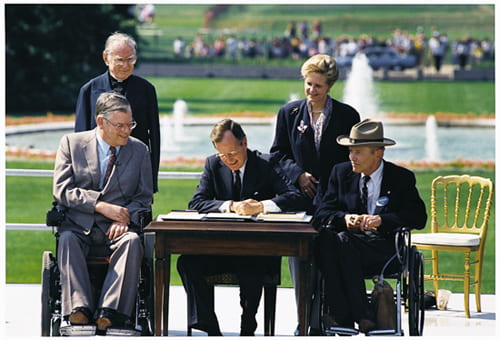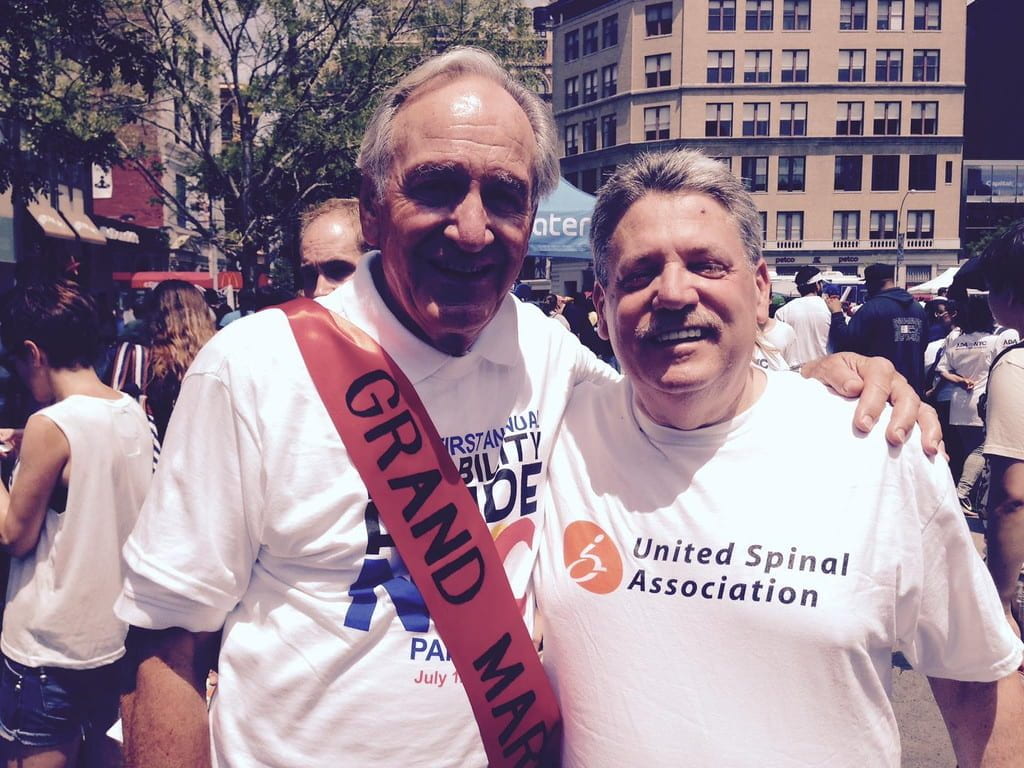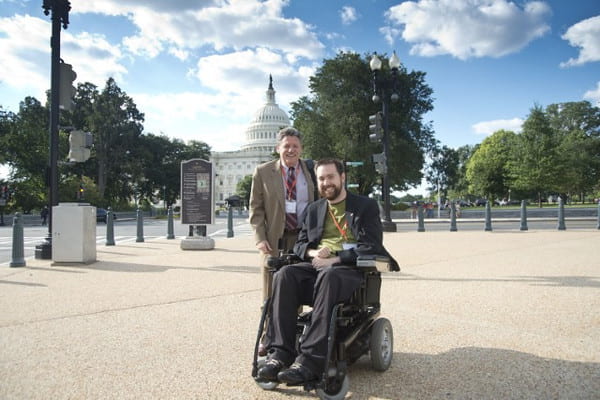* This is a repost from summer 2017
by ABBY ROSS

Today marks the 27th anniversary of the signing of the Americans with Disability Act (ADA). This was a truly groundbreaking piece of civil rights legislation that finally took permanent steps towards ensuring equality for all Americans. The ADA requires private and public entities to not discriminate against people with disabilities, and was crafted with the goal of integration in all aspects of society – employment, social settings, government, transportation, and beyond.
James Weisman, President & CEO of United Spinal Association – a nonprofit dedicated to enhancing the lives of people with spinal cord injury/disorder – has been a disability rights attorney for nearly forty years and had significant involvement in drafting portions of the Americans with Disabilities Act. He sued New York City as a young lawyer over inaccessible buses and subway stations. The implementation of mandatory bus lifts and key subway stations with elevators for wheelchair access were direct results of his lawsuit. This became the basis of the transportation sections of the ADA, and created a precedent across the country giving individuals with physical disabilities access to transportation and thus increasing independence.
Unbeknownst to Weisman, it was just the beginning of his advocacy work specifically related to transportation accessibility for wheelchair users. In the 1990s, United Spinal Association again brought litigation against the City of New York this time related to curb ramps – the corner of sidewalks that are altered to allow wheelchair users and parents with strollers to access the sidewalk from the street. The City was ordered to install ramps on all sidewalks and some twenty years later is still working to fully complete the project. He works on wheelchair accessibility in the taxi and transportation realms with companies like Uber and Lyft. With technology transforming transportation services, he remains committed to ensuring that accessibility is a priority from design to implementation across the transportation industry. Transportation is only a slice of the work that he has been involved in throughout the last forty years as disability rights truly extend to every aspect of an individual’s life. I wanted to hear his thoughts on this important anniversary, forty years of activism as well as reflections on today’s disability rights movement.

AR: What is the connection between disability rights and human rights?
JW: Disability rights has always been the bastard child of the rights movement. There is no real “ism” attached. Ableism is the closest thing but that is not definitive. Disability is in every group. There is no country, population or demographic that doesn’t include people with disabilities yet they still can face the hallmark issues of human rights discrimination. Poverty, isolation, inadequate healthcare, underemployment and exclusion are all barriers to independence and equality. People with disabilities face these issues day in and day out.
AR: Where do you see disability rights discussions and action moving in the future?
JW: For a few years, we were making significant progress across the board but with the new administration, we are back to basic rights. Now, the choice to live in the disability community is gravely threatened. Funding for support services that would allow people with disabilities to live independently, work, go to school, shop, go to the movies – live a “normal” life – is being slashed and the impact is tremendous. The proposed changes to healthcare would also have a dramatic effect on quality of life, self-sufficiency and frankly, life expectancy for severely disabled individuals. Simply staying alive is becoming a goal of advocacy again.
Apart from these issues of the day, which will likely always be present in some form, mental health stigma is the next biggest issue and will take the most work to overcome. The complexity of diagnoses and treatments paired with the lack of education and familiarity has created enormous barriers and misunderstanding.
And of course, transportation is always an issue. Innovation must include accessibility. Every new modality should be accessible from inception. – in 2017 it is ridiculous to even consider developing technology that wouldn’t include everyone and consider an aging population in design.
AR: Where have you seen the most progress in disability rights in the last 27 years?
JW: Without a doubt, it is the built environment. Physical accessibility is the easiest to measure, quantify, regulate and learn how to fix. There have been amazing advancements in what is considered normal in terms of building design and features. Automatic entries, lever style door handles, accessible restroom stalls – all things many people don’t even notice but are essential for wheelchair users and others with mobility impairments.

AR: In your opinion, what is missing from the movement?
JW: Collective identity with the rest of the country. People with disabilities are a tremendous minority group but generally not understood or engaged in the same respect that the able-bodied public is in terms of employment, education, media, advertisers, athletics, etc. Society seems to perpetually need to be re-educated about disability. The image of people with disabilities used to range from heroic to pathetic – that has changed and I believe now ranges from needy to competent but continues to be somewhat one dimensional. For instance, the wheelchair user who is the leading man’s best friend but not the leading man. One in five Americans have a disability. – We all have a friend, uncle, neighbor or colleague with a disability that we consider “our disabled guy” – we know they operate in the world, go to work, school, church, buy groceries and socialize but somehow our personal experiences are not extrapolated out to our experiences with the greater disability community.
To some degree we are missing the next generation of disability rights leaders. Many of my colleagues have been involved in these battles for thirty years or longer when the fights were about the basics – access to buildings, transportation, education. Fortunately, we have progressed since then to more sophisticated issues but there are still barriers on many fronts. The next generation of leaders will need to understand the history of the movement, the landscape of the challenges and the best possible outcomes for the disability community. We have so many bright individuals, disabled and able-bodied, that are doing wonderful work around the country – I am sure that the disability rights movement will be in good hands.
AR: What lessons have you learned in your decades of disability activism?
JW: Good ideas eventually come to fruition. It just takes time. You must keep them on the table, keep talking, keep pushing. Nothing changes if you don’t push. That often means you lose and it is one step forward three steps back but I’ve seen dramatic change in a relatively short time so I know it can happen.
Bias goes away if you expose it. Again, not necessary quickly and not completely, but every little bit helps.
I’ve found that it is extremely rewarding to be a part of this community and social fabric. I have developed extremely meaningful relationships through my work in disability rights. It is a very effect way to mature as a person – to understand the grand scale of the movement and issues as well as the microcosm of individual struggles and concerns.
AR: Finally, why should disability rights matter to every American?
JW: Dependence is expensive. Way more expensive than independence. Dependence is person specific and labor intensive whereas independence often requires only one-time investments. Motorized wheelchairs, building alterations and other assistive technologies certainly aren’t cheap but are essential tools for personal liberty. The goal of the Americans with Disabilities Act and the goal of all the work that we do around rights is simple – to give opportunity. I always say that the greatest opera ever written or the cure for cancer or other remarkable achievements may be locked in the head of an individual with disabilities who without the services, tools and right to independence will never have the opportunities they deserve to share, create and succeed. Do we want to pay to take care of everyone when the alternative – increasing access to education, employment and opportunities is by far the better alternative?
Disability rights are human rights. People with disabilities are individuals of all ages and backgrounds who are striving to be independent and active participants in society. They are moms, colleagues, wounded warriors, uncles, kids with big dreams, best friends and neighbors. They have families, jobs, hobbies, likes and dislikes and problems and joys. While the disability is an integral part of who they are, it alone does not define them.
Abby Ross is the Chief Operating Officer of United Spinal Association headquartered in NYC.
James Weisman was the General Counsel of United Spinal Association for 35 years prior to becoming President & CEO in 2015.
